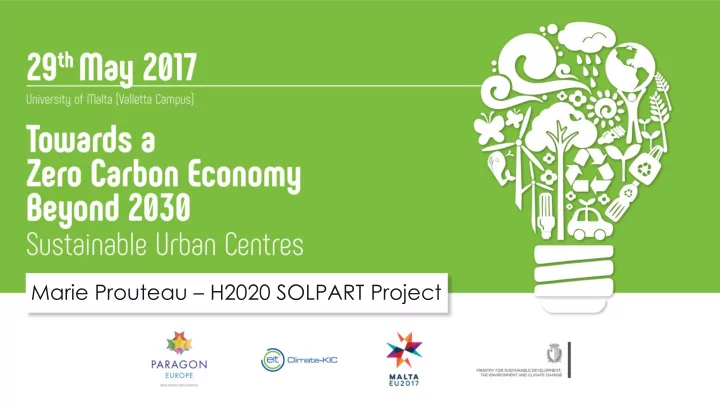

Marie Prouteau – H2020 SOLPART Project
The SOLPART project Harnessing the sun to clean up industrial processes What is the problem to solve? Energy intensive industries (i.e. the cement sector) need the major part of their energy input as thermal heat (for high-temperature chemical reactions) and are (behind the power industry) the biggest energy consumers and CO2 emitters . What could be the solution? To develop a technology that can use solar power for high-temperature industrial processes instead of using fossil fuels to produce the thermal heat needed by these energy intensive industries. Test location of the SOLPART demonstrator – CNRS-PROMES concentrated solar infrastructure (Odeillo, France)
The SOLPART project Harnessing the sun to clean up industrial processes Facts and figures about SOLPART : High Temperature Solar-Heated Reactors for Industrial Production of Reactive Particulates - Horizon 2020 funded EU project - Coordinator: Gilles Flamant - France - CNRS - 10 Partners from France, Switzerland, Germany, Spain, UK, Belgium, Morocco - Total costs : € 4 558 687 (EU contribution: € 4 366 562) - Duration 4 years: January 2016 - December 2019 - Website: http://www.solpart-project.eu/solpart- project-factsheet/ Visit of the SOLPART partners to the OCP phosphate plant in - LinkedIn:https://www.linkedin.com/groups/8596449 Morroco
The SOLPART project Harnessing the sun to clean up industrial processes Project objectives - To supply totally or partially by solar heat the thermal energy requirement for CaCO3 calcination, which is 60% of the total required energy in a cement plant and 100% of it in a lime plant. Project Results - To demonstrate a pilot scale concentrated solar reactor (about 30 kWth) operating 24h/day at about 900 ° C and suitable for reactive particle thermal treatment – high-temperature processes used in the cement or lime industries for example. DLR lab-scale rotary solar reactor to be tested for the SOLPART project
The SOLPART project Harnessing the sun to clean up industrial processes Project main expected impacts - A strong reduction in the environmental footprint - By integrating solar energy into industrial high- - New applications /fields for solar heat temperature processes, to reduce by 40% CO2 - Market transformation - Huge potential for emissions in the lime and cement industry and by adaptation of the technology to other industry 100% if the CO2 capture and sequestration are sectors applied. What is the concentrated solar energy technology to be used in the SOLPART project? - Concentrated Solar Power (CSP) plants use mirrors to concentrate sunlight onto receivers where it is converted into heat. Generally, a heat transfer fluid transports the thermal energy to a storage system and then to a power block where it is used to generate electricity. CNRS-PROMES solar tower (Targassonne, France)
Marie Prouteau - EURONOVIA m.prouteau@euronovia-conseil.eu The SOLPART project has received funding from the European Union's Horizon 2020 research and innovation programme under grant agreement n° 654663
Recommend
More recommend